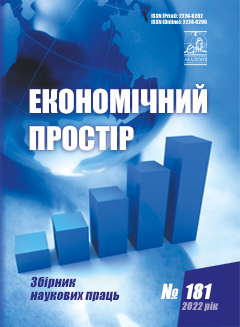СТРАТЕГУВАННЯ ПОВОЄННОГО РОЗВИТКУ НОВИХ ГАЛУЗЕЙ ПРОМИСЛОВОСТІ
Анотація
В статті розглянуті роль та підходи до стратегування повоєнного розвитку інноваційних видів діяльності у промисловому секторі. Поява нових галузей є невід’ємною частиною якісної реструктуризації національної промисловості. Розглянуто досвід розвинених країн, які внаслідок відмінностей у підходах до підтримки інноваційної діяльності в країні (високоординована та низькоординована) та характеристик інституційного середовища мали різний ступінь успішності у розвитку стратегічних галузей. Країни, що розвиваються, демонструють необхідність реалізації комплексного підходу. Часткові рішення та недостатні стимули в цих країнах стали причинами гальмування розвитку нових ринків. Розроблено рекомендації щодо завдань та інструментів стратегічного планування повоєнного відновлення та реструктуризації промислового сектору України.
Посилання
Ляховець О. Державно-приватне партнерство у вищій освіті як інституційна складова модернізації економіки. Інноваційна економіка. 2014. №4 (53). С. 71-78.
Ципліцька О.О. Інституційні механізми модернізації промислового сектору національної економіки : дис. … д-ра екон. наук : 08.00.03 / Державна установа «Інститут економіки та прогнозування НАН України». Київ, 2020. 450 с.
Best Practices in State and Regional Innovation Initiatives: Competing in the 21st Century / Ed. by Charles W. Wessner. Washington, National Academies Press. 2013. 256 p.
Casper S., Kettler H. National institutional frameworks and the hybridization of entrepreneurial business models: the German and UK biotechnology sectors. Industry and Innovation. 2001. Vol. 8, No. 1, pp. 5-30. DOI : http://dx.doi.org/10.1080/13662710120034383
Cooke P. Biotechnology clusters in the UK: lessons from localisation in the commercialisation of science. Small Business Economics. 2001. Vol. 17 (1-2). P. 43–59
Edwards J., Fischer K. Banks, Finance and Investment in Germany. Cambridge: Cambridge University Press. 2008. 268 p.
Hirschman A. The Strategy of Economic Development. 1958. Yale University Press. 230 p.
Hoshi T., Kushida K.E., Dasher R., Harada N., Okazaki T. Institutional Foundations for Innovation-Based Economic Growth / National Institute for Research Advancement (NIRA) Report. 2015. 73 p. URL: http://www.nira.or.jp/pdf/e_1503report.pdf
Jiang H., Cao Y. Research on strategic emerging industries boosting high quality economic. NETID 2020, E3S Web of Conferences 235, 02011. 2021. URL: https://doi.org/10.1051/e3sconf/202123502011
Koblianska I., Kalachevska L. Problems of the Institutional-Legal and Organizational Provision of Systemic Innovation Policy: the Case of Ukraine. Comparative Economic Research. Central and Eastern Europe. 2019. Vol. 22, No. 1. pp. 53-73. Doi: http://doi.org/10.2478/cer-2019-0004
Reversal of fortune: an assessment of the German biotechnology sector in comparative perspective / ed. Silvia J. S. American Institute for Contemporary German Studies, The John Hopkins University, 1999. 50 p.
Reynolds E.B., Uygun Y. Strengthening advanced manufacturing innovation ecosystems: The case of Massachusetts. Technological Forecasting & Social Change. 2018. No. 136, pp. 178-191. DOI: http://dx.doi.org/10.1016/j.techfore.2017.06.003
Rocha C. F., Mamédio D. F., Quandt C. O. Startups and the innovation ecosystem in Industry 4.0. Technology Analysis & Strategic Management. 2019. Vol. 31, Issue 12, pp. 1474-1487. DOI: http://doi.org/10.1080/09537325.2019.1628938
Technology Transfer Systems in the United States and Germany / National Academy of Engineering; eds. Abramson H.N., Reid P.P., Schmoch U., Encarnacao J. Washington DC: National Academy Press, 1997. 448 p.
Zang L., Xiong F., Lao X., Gao Y. Does governance efficiency matter for national innovative capacity? One tale from different countries. Technology Analysis & Strategic Management. 2019. Vol. 31, Issue 2, pp. 239-252. DOI: http://doi.org/10.1080/09537325.2018.1493450
Liakhovets O. (2014). Derzhavno-pryvatne partnerstvo u vyschiy osviti yak instytutsiyna skladova modernizatsiyi ekonomiky [Public-private partnership in higher education as an institutional component of the economy modernization]. Innovatsiyna ekonomika, no. 4, vol. 53, pp. 71-78. (in Ukrainian)
Tsyplitska O. O. (2020). Instytutsiini mekhanizmy modernizatsii promyslovoho sektoru natsionalnoi ekonomiky [Institutional mechanisms of modernization of the industrial sector of the national economy]. (PhD Thesis), State Organization «Institute for Economics and Forecasting of NAS of Ukraine», Kyiv. (in Ukrainian)
Wessner W. C., ed. (2013). Best Practices in State and Regional Innovation Initiatives: Competing in the 21st Century. Washington, National Academies Press.
Casper S., Kettler H. (2001). National institutional frameworks and the hybridization of entrepreneurial business models: the German and UK biotechnology sectors. Industry and Innovation, vol. 8, no. 1, pp. 5-30.
Cooke P. (2001). Biotechnology clusters in the UK: lessons from localisation in the commercialisation of science. Small Business Economics, vol. 17, no. 1-2, pp. 43–59
Edwards J., Fischer K. (2008). Banks, Finance and Investment in Germany. Cambridge: Cambridge University Press.
Hirschman A. (1958). The Strategy of Economic Development. Yale University Press.
Hoshi T., Kushida K.E., Dasher R., Harada N., Okazaki T. (2015). Institutional Foundations for Innovation-Based Economic Growth. National Institute for Research Advancement (NIRA) Report. Retrieved from: http://www.nira.or.jp/pdf/e_1503report.pdf
Jiang H., Cao Y. (2021). Research on strategic emerging industries boosting high quality economic. NETID 2020, E3S Web of Conferences 235, 02011. DOI: https://doi.org/10.1051/e3sconf/202123502011
Koblianska I., Kalachevska L. (2019). Problems of the Institutional-Legal and Organizational Provision of Systemic Innovation Policy: The Case of Ukraine. Comparative Economic Research. Central and Eastern Europe, vol. 22, no. 1, pp. 53-73.
Silvia J. S., ed. (1999). Reversal of fortune: an assessment of the German biotechnology sector in comparative perspective. American Institute for Contemporary German Studies, The John Hopkins University, 50 p.
Reynolds E.B., Uygun Y. (2018). Strengthening advanced manufacturing innovation ecosystems: The case of Massachusetts. Technological Forecasting & Social Change, no. 136, pp. 178-191.
Rocha C. F., Mamédio D. F., Quandt C. O. (2019). Startups and the innovation ecosystem in Industry 4.0. Technology Analysis & Strategic Management, vol. 31, issue 12, pp. 1474-1487.
Abramson H.N., Reid P.P., Schmoch U., Encarnacao J., eds. (1997). Technology Transfer Systems in the United States and Germany. National Academy of Engineering. Washington DC: National Academy Press.
Zang L., Xiong F., Lao X., Gao Y. (2019). Does governance efficiency matter for national innovative capacity? One tale from different countries. Technology Analysis & Strategic Management, vol. 31, issue 2, pp. 239-252.



